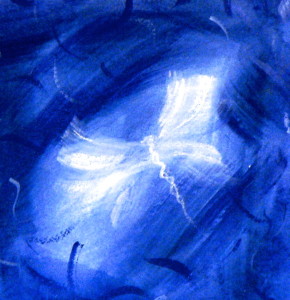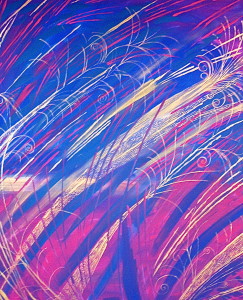
– Art by Jan Ketchel
I lie awake. It’s 2 AM and I can’t sleep. It’s the energy of now, I think, the restlessness of this time of transformation. My mind races. Thoughts swirl. An hour goes by. I still can’t sleep. I should get up, I think, go sit by the wood stove and meditate or read, but it’s too cold. I snuggle down in bed, pulling the covers up higher.
I say my mantra: “Look into your darkness until you see the eye of God.” I repeat it, looking into the darkness behind my eyes. As usual I see all kinds of eyes. Faces loom, strange and wonderful, eerily looking right back at me. I know that they are all eyes of God. God is in everyone and everything, whatever God may be. To me, God is the energy of all of us and of everything, not a being but simply who we all are. But I cannot still my humming mind.
I should be able to handle this, I think, I’m a hypnotist after all! I do self-hypnosis. I go to a calm place, a safe place, a beautiful place. I go deeper into my body, relaxing each muscle, calming my thoughts one at a time, dismissing them as soon as they arise. Without attachment, I let them go, knowing they will reappear again in the morning. Another hour passes. I still cannot fall back to sleep.
Now I open my eyes. Instead of looking into my inner darkness I peer into the night. This has always been a fascination of mine, another kind of mediative practice that I’ve always done. As I stare into the darkness of the bedroom I see energy, swirling, twirling, flipping and soaring energy that immediately comforts me. Yes, this is good, I think. And I wonder if Jeanne will come to me, for this is often how she appears, in her energy body, as a fluttering globe of white light, a white moth surrounded by an ethereal glow in the dark of night.
Once, when I told Chuck that this was how I saw her, we lay on our bed in the darkness one night and looked for her together. I am a visual person. I see things, actually see. I believe everyone can see the same way, see the same things, but I also know that we are all constructed differently and some parts of us are more dominant and more exercised than others. I’ve always been like this. I have a kind of synesthesia where I see numbers in designs; the days of the week, the hours of the day, the months of the year each with their own specific layout. When I do math, I see the numbers in their places on the spiraling pattern that always appears when I think of numbers. I calculate by visualizing. If I think of the days of the week, Wednesday for instance, there it is, right where it always is in the weekly design layout. I see words in shapes and colors. I thought everyone saw the same way, but now I know differently, that we all perceive the world in our own unique way.
I know that Chuck does not see the way I do. Where I am visual, he’s intuitive. So it stands to reason that his way of perceiving things is different. He was always a good hypnosis subject when I was doing my training because I could never ask him to visualize something, to see it in his mind’s eye. He challenged me to go beyond my own perception, to accept and allow for other possibilities. Everything is abstract to him, he feels things, while to me everything has shape and form, so I knew that when I asked him to look into the darkness with me on that night, I was asking him to come into my world, a very different world from the one he normally inhabits.

-Art by Jan Ketchel
“Don’t look too hard,” I said, “gaze the way the Shamans say to gaze. Notice that the darkness is not just one color. Notice that it’s not solid, that it’s in constant flux. Do you see that reddish light over there to the left?” I wondered if he could indeed see what I was perceiving. After a while, he said yes, and he described exactly what I saw.
“See how it moves?” I asked.
“Yes,” he said.
“Well,” I said, “that’s energy moving in the universe. That’s what the Shamans of Ancient Mexico talk about. We are all that.”
The other night, when I looked into the darkness, I called Jeanne to me, as I often do. “Are you there?” Out of the darkness she came.
“I can’t sleep,” I said. “Help me to sleep.” Her white fluttering globe came closer and closer until I blacked out.
In the morning, I was grateful that I had gotten a few more hours of sleep, but I clearly saw the power of the conscious mind, how it fights for precedence and how insidious our thoughts are, never willing to release us. The conscious mind feeds off us all day long and if we wake up at night it’s there waiting to suck our energy again. I went through a few more nights like that before, finally worn out perhaps, I slept deeply and solidly. I’d wake briefly but, without attachment, fall easily back to sleep after staring into the energy of the darkness. This activity, as well as being in my usual world, has also provided me with inspiration, the basis of many of my abstract paintings, the seeing of energy, day or night. Anyone can do it. Try it, whether sleepless of not, it’s quite an exhilarating experience. Allow the solid world to slowly dissolve into energy— vibratory strings, lines, dots—not unlike the pixilation of a digital image.
Perhaps the energy outside of us will calm down soon, perhaps we’ll all ride it to a new level. Perhaps, as Jeanne suggested in her message the other day, you’ll “Learn to flow with what comes and your fulfillment will loom large before you.” That’s what it’s like when I stare into the darkness, my fulfillment looms large before me. It comes to meet me, to speak to me in a different way, in image and abstraction, in the clarity of intuition that has no basis in visual seeing, but only exists in seeing the energy that we all are.
May you all be well and keep flowing!
Jan
